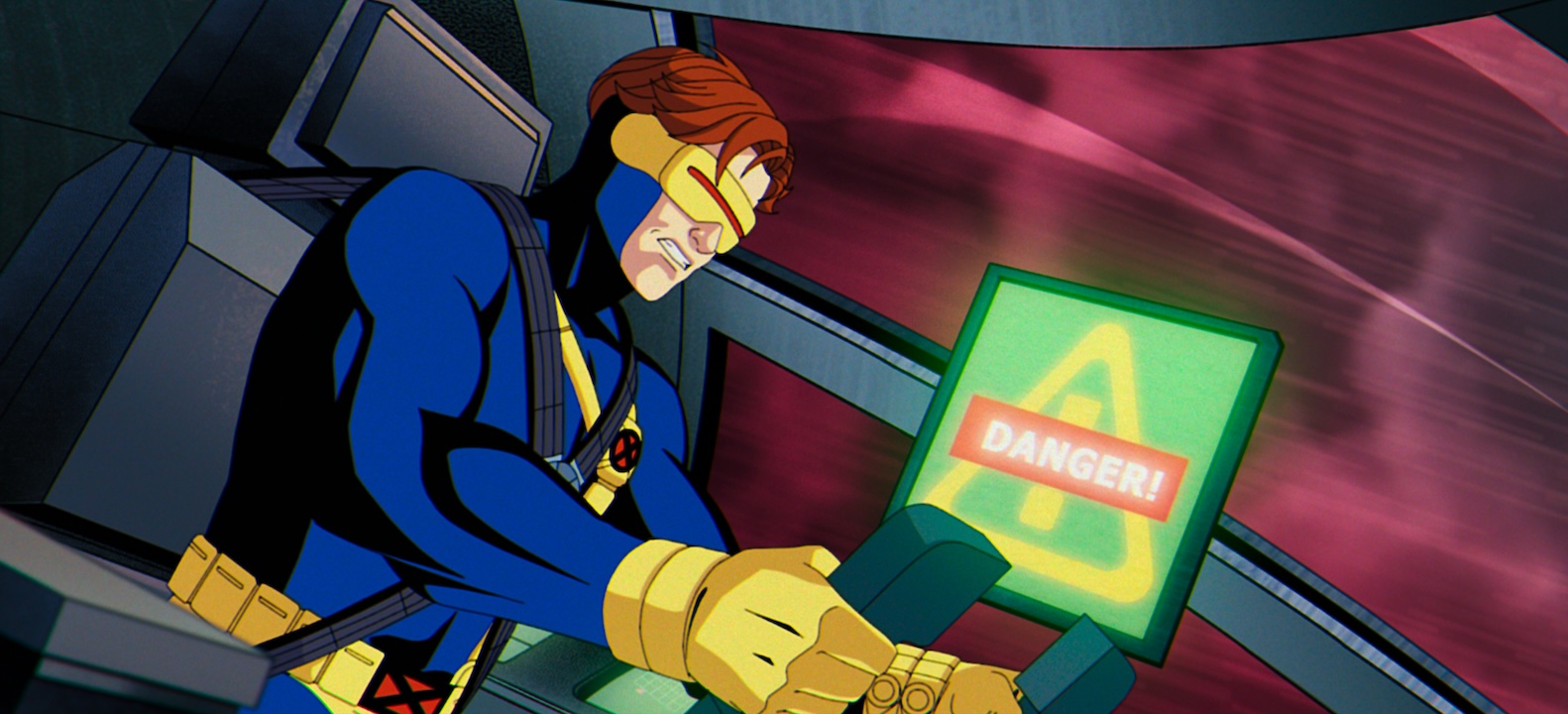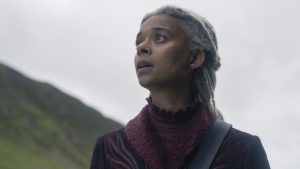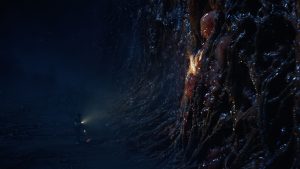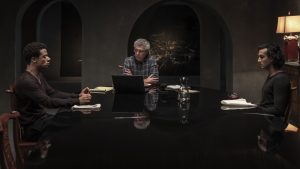
This X-Men ’97 article contains spoilers.
“Tastes like chicken.” If that phrase brings to mind the evil mutant the Blob chowing down on the Wasp’s corpse, then the ending of X-Men ’97‘s eighth episode, “Tolerance Is Extinction Part One,” should send shivers down your spine.
After all, Magneto’s decision to attack the entire planet Earth in X-Men ’97 has a lot in common with the inciting event of Ultimatum, the 2009 Marvel event that somehow made the already grim and edgy Ultimate Marvel Universe even grimmer and edgier, to very mixed results.
The connections between Ultimatum and “Tolerance Is Extinction Part One” only stand out more when one considers all of the many cameos in the episode, which showed that anti-mutant bigotry isn’t just limited to the X-Men, but it affects the entire Marvel Universe.
Here’s a breakdown of all the cameos in the star-studded episode as well as what that ending could mean for the rest of the first season…
Photo: Marvel Animation.
Spider-Man
Our friendly-neighborhood Spider-Man needs no introduction. Whether Peter Parker or Miles Morales (or Ben Reilly, or Miguel O’Hara, or…), people know and love Spider-Man. In fact, many older nerds (read: this author) first met the X-Men through Spider-Man and His Amazing Friends, the not-very-good ’80s cartoon show that teamed Spidey with mutants Firestar and Ice Man.
Save for a couple of embarrassing moments here and there, Spidey has been a staunch ally of the mutants, mostly because he also knows a thing or two about being hated and feared. “Tolerance is Extinction Part One” doesn’t give him much to do, but Spider-Man’s presence signals some tough decisions ahead for Marvel’s heroes.
Photo: Marvel Animation.
William Stryker
William Stryker just shows up on a television screen in the background of a shot in “Tolerance Is Extinction Part One,” which might surprise people who only know the character from X2: X-Men United. In that movie, General William Stryker (Brian Cox) seems like the last person to go on television, for any reason. But the Stryker of the comics, first introduced in the legendary storyline God Loves, Man Kills, is actually a religious leader who preaches hatred against mutants.
Stryker was one of the major antagonists who did not show up on X-Men: The Animated Series, but it’s easy to see how the destruction of Genosha would embolden him to finally appear in animated form.
Photo: Marvel Animation.
Henry Peter Gyrich
Few humans have annoyed the X-Men like Henry Peter Gyrich. Initially a liaison between the U.S. government and the Avengers, Gyrich soon proved himself to be a pencil-pushing problem for Marvel’s mutants as well. In the comics, Gyrich tends to be less of a villain and more of a reasonable person who mistrusts people with superpowers.
However, in X-Men: The Animated Series, Gyrich is a straightforward villain, a man who supported Senator Robert Kelly’s Mutant Registration Act and continued to pursue state-sponsored violence against mutants even after Kelly had a changed of heart. Gyrich plagued the X-Men throughout the Animated Series, but the latest episode of X-Men ’97 declares the villain dead, suggesting his threat has finally come to an end.
Photo: Marvel Animation.
Polaris
Even by X-Men standards, Polaris has a convoluted history. She first appeared in ’60s X-Men issues as just another mutant who could control metal. Although many wondered if she had any connection to Magneto, nothing was confirmed until fairly recently, when she was declared the only true daughter of the Master of Magnetism, as Scarlet Witch and Quicksilver have lost their mutant status. Polaris also has a long romantic history with Havok, especially when the two served in X-Factor together.
Polaris made a few appearances in X-Men: The Animated Series, but her latest appearance occurs in the future that Cable describes, in which she has been enslaved by Bastion and the humans. However, one cannot help but notice that she, like her father, is bombarding the planet with magnetic rays.
Photo: Marvel Animation.
Rachel Summers
The other major mutant in the future scenes rivals Polaris for confusing histories. Rachel is the daughter of Scott Summers and Jean Gray. Simple, right? Well, she’s the daughter from the future seen in Days of Future Past, a potential future that likely doesn’t exist. Moreover, in that future, she was a “hound,” a mutant enslaved by humans and used to hunt other mutants.
In modern X-Men comics, Rachel lives in the present alongside her parents and other contemporary mutants, often fighting alongside Excalibur under the codenames Phoenix or Prestige. However, the image of her in X-Men ’97 shows her in her hound form, with lines across her face, suggesting that she cannot escape her darkest future.
Photo: Marvel Animation.
Doctor Doom
With the exception of the X-Men, Doctor Doom might be the character that people most want to see in the MCU. In addition to being the arch-enemy of Reed Richards and the Fantastic Four, Doctor Victor Von Doom is the benevolent despot who rules the Eastern European nation of Latveria. He’s also a master sorcerer and genius inventor, making him a formidable figure in the Marvel universe.
With so many accomplishments, it’s easy to see why Doom’s most defining quality is his unbridled arrogance. So while Doom doesn’t hate mutants, he rejects out of hand the notion that anyone — human, mutant, or otherwise — is superior to him.
Photo: Marvel Animation.
Baron Zemo
Believe it or not, the purple-hooded figure who weighs in on the state of the mutants is someone MCU fans have seen before. That’s Baron Helmut Zemo, the chief antagonist in Captain America: Civil War, played by Daniel Brühl. Although Zemo got a little flamboyant in The Falcon and the Winter Soldier, even pulling on his purple mask for a bit, Brühl mostly portrayed a more grounded, realistic Zemo, a citizen of Sakovia who sought vengeance against the superheroes.
The Baron Zemo of X-Men ’97 has a lot more in common with his comic book predecessor. The Zemo of the comics is the son of Baron Heinrich Zemo, a World War II-era German nobleman who battled with Captain America. The younger Baron Zemo carries on his father’s fight with Cap, but also troubles the Avengers as the leader of the Masters of Evil. Zemo’s most devious plan occurred when the supervillain Onslaught killed the Avengers and the Fantastic Four. In those teams’ absence, Zemo and the Masters of Evil masqueraded as a new team of heroes: the Thunderbolts.
Photo: Marvel Animation.
Juggernaut
X-Men ’97 has kept Xavier largely off-screen, as he convalesces with Lilandra in Shi’ar space. But in episode eight, Morph took the form of one of Xavier’s relatives, the unstoppable Juggernaut, aka Cain Marko. This villain is Xavier’s step-brother, the son of his mother’s second husband Kurt Marko.
The two boys grew up as rivals, which only increased when Xavier’s mutant abilities manifested. Cain leveled the playing field by finding the mystical Crimson Gem of Cyttorak, which gave him great strength and durability. A constant in X-Men comics since the 1960s, Juggernaut has appeared in X-Men: The Animated Series, making him a familiar face for long-time fans.
Photo: Marvel Animation.
Omega Red
Of course the Russian mutant Omega Red appeared in the original X-Men: The Animated Series. After all, Omega Red is an incredibly ’90s character, another adamantium-based super solider to battle Wolverine, complete with a wiped memory. In fact, Omega Red appeared in four episodes of TAS. He hasn’t caused the X-Men much trouble in the current series, but it appears that Magneto’s actions have called him back into service, so he might be back to battle Wolverine again.
Photo: Marvel Animation.
Silver Samurai
Close watchers might recall the Silver Samurai as the chief antagonist of 2013’s The Wolverine. At the end of that film—you know, the point where most people turn off the film, Ichirō Yashida (Haruhiko Yamanouchi) mans a giant robot in the form of the Silver Samurai.
The version that briefly appears in X-Men ’97 is a more complicated figure. The first Silver Samurai, named Kenuichio Harada, debuted as a Daredevil villain before playing a key role in Wolverine’s adventures in Japan. As a mutant, the Silver Samurai can energize his katana and armor, enhancing his mastery of samurai combat. Although he and Wolverine often clash, the Silver Samurai has a nobility that drives him to heroic actions from time to time.
Photo: Marvel Animation.
Nina Da Costa
Nina Da Costa, the mother of New Mutant Roberto Da Costa aka Sunspot, represents a huge change from the original comics. In the pages of The New Mutants and X-Men, Nina Da Costa is a white Brazilian woman who works as an archeologist. Nina clashed with Roberto’s father, the rich and powerful Black Brazilian Emmanuel Da Costa, especially over their son. While Nina always supported Roberto, Emmanuel worried about how a mutant son would affect his reputation.
Eventually, Emmanuel joins the Hellfire Club, a powerful group of super-rich mutants who seek economic control rather than fight for the rights for their people. They manipulated the bigoted Emmanuel to gain access to his wealth and potentially influence Sunspot and other young mutants. Eventually, Emmanuel died, leaving his money to Roberto.
X-Men ’97 gives us a radically different take of Nina. Not only is this Nina darker-skinned than her red-headed comic book equivalent, but she also acts more like Emmanuel. She supports Roberto — as long as he doesn’t upset her social standing. “Tolerance Is Extinction Part One” ends with her allowing Roberto and Jubilee to go into custody, which certainly seems to make her more of a villain than her counterpart in the comics.
Photo: Marvel Animation.
Val Cooper
Given her key role in debating with Magneto and eventually freeing the Master of Magnetism from Bastion’s clutches, it isn’t accurate to say that Val Cooper has a mere cameo in “Tolerance Is Extinction Part One.” However, she has a complex history that deserves more explanation.
In the comics, Dr. Valerie Cooper tends to serve as liaison between the U.S. government and mutants of the world. She first debuted in 1983’s Uncanny X-Men #176, where she advocated for government actions against not just mutants but all superheroes. She soon saw the value of having mutants on one’s side and foolishly recruited Mystique’s version of the Brotherhood of Evil Mutants to work for the government as the Freedom Force. When using people who call themselves the Brotherhood of Evil Mutants turned out to be a bad idea, Cooper tried again by assembling X-Factor, a mutant team led by Cyclops’ brother Alex.
In X-Factor, Cooper largely served as a sympathetic ally to mutants who also had no problem using them to her own political advantage. Her portrayal on X-Men ’97 follows this basic model, as she expresses horror at the events of Genosha while also retaining skepticism about Magneto’s turn to heroism. In many ways, Val embodies the best that human allies can do: supportive when it serves them, but quick to betray mutants when it suits them.
But if that’s the case, why does “Tolerance Is Extinction Part One” end with Val declaring “Magneto was right?” The simple answer might be that the horror of Genosha and Bastion forced her to change her mind. But the more complex answer, and therefore the most popular theory X-Men fans are currently trading online, is that Val has been replaced by Mystique. Under the guise of Val Cooper, Mystique may be undermining Bastion, which will eventually give the X-Men an edge against the Prime Sentinels.
Then again, much like Cooper, Mystique always works for herself (or her wife Destiny) first, which means that she may not have the interests of other mutants in mind.
Photo: Marvel Animation.
The “Tolerance Is Extinction Part One” Ending and Ultimatum
As fun as these cameos are, they serve a larger thematic purpose. The X-Men have always fought to realize Xavier’s dream of coexistence between humans and mutants. Genosha seemed to represent the most realistic version of that dream, with mutants establishing their own nation, where they won’t be in competition with most humans. And yet, not even that stopped humanity’s attacks, prompting an extraordinary response.
The destruction of Genosha represents the global scale of anti-mutant hatred, while the cameos show that characters around the Marvel world, even those who have little to do with the X-Men, have to address the issue. That reminder comes into play in the final moments, when Val Cooper/Mystique frees Magneto. Against the extreme hatred he experiences, Magneto rejects his friend Xavier’s will and dream and fights against humanity by creating an EMP that covers the world.
The EMP destroys the Prime Sentinels that almost defeated the X-Men. But it’s clear that Magneto’s actions have larger worldwide consequences, even if we don’t see them yet.
Will the consequences be as bad as those in Ultimatum? We certainly hope not, as X-Men ’97 has been much, much better than almost anything from that era of Ultimate Marvel. For those who had the good fortune or good taste to skip Ultimatum, the story begins with Magneto getting sick of humanity and reversing the magnetic poles of the planet. As a result, tsunamis destroy many American cities, including New York, and drown thousands. Those drowning deaths included X-Men such as Beast and Dazzler as well as non X-characters such as Daredevil and Franklin Storm.
If that’s not bleak enough, the rest of the story mostly consists of other characters dying gnarly deaths. Dormammu pops off the head of Doctor Strange. Madrox the Multiple Man turns his dupes into suicide bombers that destroy Emma Frost, Hank Pym, and Polaris. Sabretooth eats Angel. Magneto snaps Xavier’s neck and tears apart Wolverine before Cyclops blows his head off. And yes, the Blob eats the Wasp, until he gets his head bitten off by Giant Man.
If you’re wondering if writer Jeph Loeb and artist David Finch matched this carnage with any substance or thematic concerns, the answer is no. Ultimatum is nothing but five issues of nonstop superhero death.
So while final two episodes in “Tolerance is Extinction” will find Xavier and his students dealing with horrible consequences, Ultimatum shows that it could get much, much worse. Let’s hope X-Men ’97 steers clear of those comics.
X-Men ’97 is streaming now on Disney+.
The post X-Men ’97 Episode 8 Cameos and Ending Just Set Up an Infamous X-Men Story appeared first on Den of Geek.







